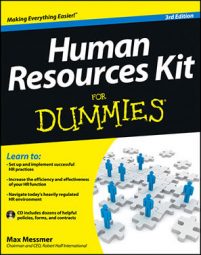The easiest way to make a hiring decision for your business is to weigh the options and simply go with what your intuition tells you to do. Easy — but risky. Gut decisions, whether they originate from one person or a group of people, are almost always biased in the following respect: Their roots tend to be firmly planted in wishful thinking.
Decision makers in companies with good track records of making successful hires don’t give themselves the luxury of relying solely on intuition. They use — and generally trust — their intuition, but they don’t focus on intuition as the sole basis for their judgments. The following list describes what these decision makers rely on.
They have in place some sort of system — a well thought-out protocol for assessing the strengths and weaknesses of candidates and applying those assessments to the hiring criteria. These decision makers always make it a point, for example, to precede any face-to-face interview with a phone conversation. And they’ve established a set of steps that they routinely follow after they’ve interviewed a candidate.
The system that they use, regardless of how simple or elaborate, is weighted — that is, it presupposes that certain skills and attributes influence job performance more than others do, and it takes those differences into account. They know, for example, that the personal qualities that underlie effective performance in sales aren’t necessarily the same ones that underlie effective performance in, say, administrative jobs.
They constantly monitor and evaluate the effectiveness of the system — always with an eye toward sharpening their own ability and the ability of others to link any data they obtain during the recruiting and interviewing process to the on-the-job performance of new hires.
If a particular type of testing mechanism is used in the selection process, the validity of the test (how closely the test results correlate with successful on-the-job performance) is monitored on a regular basis.
Some companies invest a great deal of money in developing elaborate selection procedures, the express purpose of which is to make the candidate evaluation process more objective and accurate. Whether you want to go that route is up to you, but here are some fundamental steps you must go through with all such processes, regardless of cost.
Isolate key hiring criteria.
By this point in the hiring process, you should know what combination of skills and attributes a candidate needs to perform the job well and fit your company’s pace and culture.
Set priorities.
You can safely assume that some of your hiring criteria are more important than others. To take these differences into account, and, depending on the nature of the particular position at issue, some employers may want to set up a scale that reflects the relative importance of any particular skill or attribute.
Evaluate candidates on the basis of the weighted scale you established in Step 2.
Instead of simply looking at the candidate as a whole, you examine each of the criteria you set up, and you rate the candidate on the basis of how he measures up in that particular category.
This weighted system of evaluation takes into account the performance priorities unique to each of the key hiring criteria. It helps ensure that the requirements of the job reasonably align with the strengths and weaknesses of the candidate.
All in all, a weighted system gives you an opportunity to see how well candidates measure up against one another and how closely their skills and attributes match the job requirements. You must be careful, however. The effectiveness of this system depends on two crucial factors: the validity of your hiring criteria and the objectivity of the judgments that underlie any ratings you assign to various candidates.

